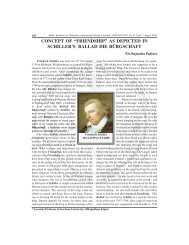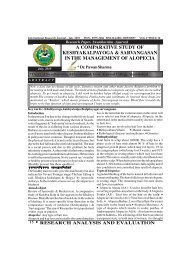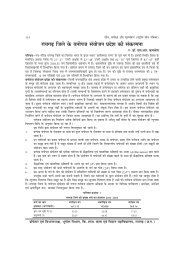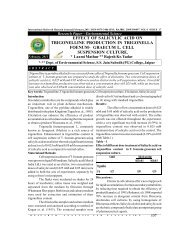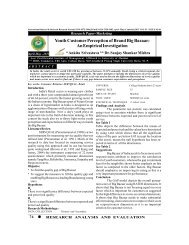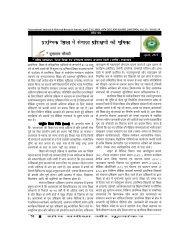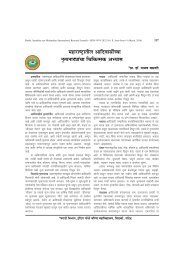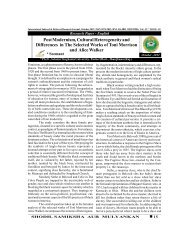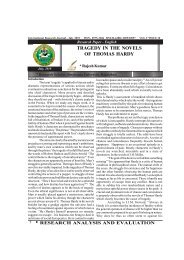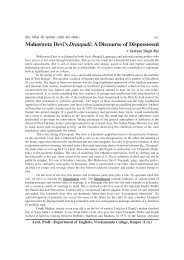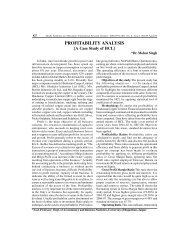Problems related to Participation in Mathematics in 10 + 2 Standard ...
Problems related to Participation in Mathematics in 10 + 2 Standard ...
Problems related to Participation in Mathematics in 10 + 2 Standard ...
You also want an ePaper? Increase the reach of your titles
YUMPU automatically turns print PDFs into web optimized ePapers that Google loves.
International Indexed & Refereed Research Journal, February, 2013 ISSN 0975-3486, (Pr<strong>in</strong>t) , E- ISSN – 2320-5482 ,RNI –RAJBIL- 2009-30097, VOL- IV * ISSUE- 41<br />
February,2013<br />
Research Paper—<strong>Mathematics</strong><br />
<strong>Problems</strong> <strong>related</strong> <strong>to</strong> <strong>Participation</strong> <strong>in</strong> <strong>Mathematics</strong> <strong>in</strong><br />
<strong>10</strong> + 2 <strong>Standard</strong> of Arts and Science Streams:<br />
AComparative Study <strong>in</strong> Goalpara District of Assam<br />
*Abdul Wahed ** Sah<strong>in</strong> Ahmed<br />
* Bikali College, Dhupdhara, P.O.-Dhupdhara. Dist-GOALPARA (Assam)<br />
** Goalpara College, Goalpara,P.O.+ Dist- Goalpara (Assam).<br />
A B S T R A C T<br />
There is a consensus that the participation, achievement, dropout and curricula aspects are the ma<strong>in</strong> hurdles for expansion<br />
and generalization of mathematics education despite its immense importance as one of the discipl<strong>in</strong>es <strong>in</strong> all streams of<br />
learn<strong>in</strong>g. To assess the ground reality <strong>in</strong> respect <strong>to</strong> the above issues, especially <strong>in</strong> <strong>10</strong> +2 standard <strong>in</strong> rural area of Assam,<br />
an <strong>in</strong> depth study is felt necessary. The study about these issues are sought <strong>to</strong> <strong>in</strong>duct <strong>in</strong> Goalpara, one of the backward<br />
Districts of Assam which has 5 colleges and 4 higher secondary schools offer<strong>in</strong>g mathematics <strong>in</strong> +2 standard. Information<br />
regard<strong>in</strong>g the issues are collected from primary as well as secondary sources. For secondary sources official records from<br />
concern<strong>in</strong>g authorities are gathered. The primary <strong>in</strong>formation are gathered from 30 respondents [mathematics teachers].<br />
On the basis of the <strong>in</strong>formation gathered <strong>in</strong> this way, this paper attempts <strong>to</strong> highlight the status of mathematics education<br />
and <strong>to</strong> f<strong>in</strong>d the rate of participation, achievement and dropout <strong>in</strong> +2 standard.<br />
KEY-TERMS: The study uses the terms given here<strong>in</strong> <strong>in</strong> the sense of its own limitations. <strong>10</strong>+2 standard: Higher secondary [11th<br />
& 12th] classes. Enrolment: Total number of students <strong>in</strong> a particular class. <strong>Participation</strong>: Take part <strong>in</strong> the study programme<br />
of mathematics and appeared <strong>in</strong> the exam<strong>in</strong>ation. Achievement: Passed <strong>in</strong> mathematics. Dropout: Difference <strong>in</strong> the number<br />
of participation <strong>in</strong> 12th class from 11th class of preced<strong>in</strong>g year. Excess: Negative dropout. Curricula: Plural of curriculum<br />
which is conf<strong>in</strong>ed only <strong>in</strong> the syllabus of mathematics <strong>in</strong> +2 standard. PGT: post graduate teacher<br />
Introduction:<br />
<strong>Mathematics</strong> develops our power of th<strong>in</strong>k<strong>in</strong>g,<br />
reason<strong>in</strong>g, judgment and generalization [Sidhu,<br />
1995].Therefore, it plays an important role for scientific<br />
and socio-economic development of a country. The<br />
needs and requirements of the modern civilization<br />
based upon computer, sophisticated technology and<br />
global commercialization demand for skilled labour with<br />
sound mathematical knowledge. Poor participation and<br />
low enrolment fac<strong>to</strong>rs <strong>in</strong> mathematics will decrease the<br />
skillful labour <strong>in</strong> the society. Importance of mathematics<br />
<strong>in</strong> the chang<strong>in</strong>g scenario of the society and the<br />
ongo<strong>in</strong>g gloomy situation necessitates study<strong>in</strong>g the<br />
present status of mathematics education. Under this<br />
perspective an attempt has been made <strong>to</strong> assess the<br />
status of mathematics <strong>in</strong> terms of participation, achievement<br />
and dropout <strong>in</strong> higher secondary classes. The<br />
study also tries <strong>to</strong> search the reasons for the deteriorat<strong>in</strong>g<br />
enrolment <strong>in</strong> the subject as a whole and <strong>in</strong> particular<br />
<strong>to</strong> Goalpara District of Assam.<br />
The choice of the <strong>to</strong>pic is disposed on the<br />
current world trend and research emphasis on the short<br />
fall of the qualified person <strong>in</strong> the society with sound<br />
mathematical knowledge as required by <strong>in</strong>dustry and<br />
bus<strong>in</strong>ess sec<strong>to</strong>r of the country [Report of the Royal<br />
Society, 2008; Koun<strong>in</strong>e et.al. 2008]. In a study of <strong>in</strong>ternational<br />
comparison of post-16 mathematics education<br />
<strong>in</strong> 24 different countries Hodgen et. al. [20<strong>10</strong>] revealed<br />
that England, Wales and Northern Ireland have<br />
the lowest levels of participation <strong>in</strong> upper secondary<br />
mathematics. To eradicate such problem they along<br />
with Noyas [2011] suggested <strong>to</strong> offer different types<br />
and level of mathematics <strong>in</strong> post-16 curriculum with<strong>in</strong><br />
the context of current and projected social and economic<br />
needs. Thus, consider<strong>in</strong>g socio-economic necessity<br />
and demand for STEM[science, technology,<br />
eng<strong>in</strong>eer<strong>in</strong>g and mathematics] many countries such as<br />
Germany, Hong Kong and New Zealand have already<br />
been <strong>in</strong>troduced compulsory basic mathematics <strong>in</strong><strong>to</strong><br />
upper secondary level [Hodgen, et.ai., 2013].<br />
<strong>Mathematics</strong> education is still lagg<strong>in</strong>g <strong>to</strong> fulfill<br />
the social need <strong>in</strong> our country. In view of the importance<br />
of mathematics which is deeply <strong>in</strong>volved with all<br />
the issues affect<strong>in</strong>g society [Ambrosio, 2003] and consider<strong>in</strong>g<br />
the deteriorat<strong>in</strong>g situation many researchers<br />
[Varadarajan, 1983; James, et.al. 2012] suggested that<br />
the curriculum of mathematics should be dynamic and<br />
<strong>related</strong> <strong>to</strong> everyday life. It needs <strong>to</strong> be reframed by a<br />
different philosophy and set of values, so that it can<br />
fulfill the need, hope and aspiration of the majority<br />
students [Noyas, 2007]. Thus curriculum, pedagogy<br />
and assessment should be designed <strong>to</strong> enable all students<br />
<strong>to</strong> be able <strong>to</strong> use mathematics <strong>in</strong> their professional<br />
and everyday life.<br />
In the context of our country there is a say<strong>in</strong>g<br />
that the curriculum of higher secondary mathematics<br />
has been framed giv<strong>in</strong>g priority and importance <strong>to</strong> the<br />
need of the science students only and ignor<strong>in</strong>g the<br />
RESEARCH ANALYSIS AND EVALUATION<br />
48
International Indexed & Refereed Research Journal, February, 2013 ISSN 0975-3486, (Pr<strong>in</strong>t) , E- ISSN – 2320-5482 ,RNI –RAJBIL- 2009-30097, VOL- IV * ISSUE- 41<br />
necessity of others. As a result poor participation <strong>in</strong><br />
mathematics has been experienced year after year <strong>in</strong><br />
arts stream. The observation demands <strong>to</strong> f<strong>in</strong>d out the<br />
answer of an important question why the arts students<br />
don't come forward <strong>to</strong> take part <strong>in</strong> the study programme<br />
of mathematics <strong>in</strong> +2 standard. For answer<strong>in</strong>g this basic<br />
question, this paper sets the follow<strong>in</strong>g key research<br />
questions.<br />
Research Question:<br />
The study proposes <strong>to</strong> address the follow<strong>in</strong>g<br />
research questions <strong>in</strong> relation <strong>to</strong> the status of mathematics<br />
<strong>in</strong> +2 standard of arts & science streams-<br />
1. What are the rates of participation and achievement<br />
<strong>in</strong> mathematics?<br />
2. Whether there exists any relationship between<br />
participation and achievement <strong>in</strong> mathematics?<br />
3. Whether the number of dropout is significant?<br />
4. Is the exist<strong>in</strong>g syllabus of mathematics feasible for<br />
all the streams?<br />
5. Are there any need of separate syllabus for arts &<br />
science streams?<br />
Methodology:<br />
The study programme of mathematics <strong>in</strong> +2<br />
level is available only <strong>in</strong> 9 <strong>in</strong>stitutions compris<strong>in</strong>g 5<br />
colleges and 4 higher secondary schools <strong>in</strong> Goalpara<br />
District of Assam. Moreover, there are 173 Secondary<br />
& higher secondary schools <strong>in</strong> the district offer<strong>in</strong>g<br />
compulsory mathematics programme up <strong>to</strong> <strong>10</strong>th class.<br />
All the <strong>in</strong>stitutions as mentioned above constitute the<br />
population for the present study. Secondary <strong>in</strong>formation<br />
regard<strong>in</strong>g participation and achievement <strong>in</strong> mathematics<br />
<strong>in</strong> +2 level are gathered from official records as<br />
provided by the concern<strong>in</strong>g authorities of the 9 <strong>in</strong>stitutions.<br />
Stratified sampl<strong>in</strong>g technique is applied <strong>to</strong><br />
gather primary <strong>in</strong>formation through a pre tested teachers'<br />
questionnaire.<br />
There are 20 [Prof. & PGT] mathematics teachers<br />
<strong>in</strong> +2level. Besides these 20 teachers another <strong>10</strong><br />
mathematics teachers are selected randomly from 161<br />
graduate mathematics teachers work<strong>in</strong>g <strong>in</strong> the district.<br />
Thus, the sample size taken is 30 number of mathematics<br />
teachers. From these 30 respondents primary <strong>in</strong>formation<br />
are gathered regard<strong>in</strong>g their views <strong>in</strong> the mathematics<br />
curricula of +2 standard. This study is descriptive<br />
<strong>in</strong> nature and common statistical <strong>to</strong>ols such as,<br />
correlation coefficient, mean, S.D., paired t-test, and<br />
percentage are applied <strong>to</strong> analyze the data.<br />
Analysis:<br />
4.1 <strong>Participation</strong> and Achievement:<br />
For both the streams the percentage of participation<br />
and achievement <strong>in</strong> mathematics are found<br />
year wise separately from the field survey report [see<br />
appendices-i & ii] and their averages for<strong>10</strong> years [from<br />
2002 <strong>to</strong> 2011] are given <strong>in</strong> the follow<strong>in</strong>g table-1 for direct<br />
comparison.<br />
See Table 1 In table-1 it is found that the average rate<br />
of participation <strong>in</strong> mathematics for 11th class is 11.15%<br />
and average rate of achievement aga<strong>in</strong>st participation<br />
is 38.21%, whereas <strong>in</strong> case of 12th class average rate of<br />
participation and achievement are found 11.43% &<br />
62.39% respectively. Another remarkable f<strong>in</strong>d<strong>in</strong>g of this<br />
table is that the arts and science streams witnessed two<br />
different tendencies regard<strong>in</strong>g participation and<br />
achievement <strong>in</strong> mathematics.<br />
In arts stream the rates of participations <strong>in</strong><br />
mathematics are very low [1.66 & 1.30] whereas their<br />
achievement are high [40.42 & 44. 97.]. But <strong>in</strong> science<br />
stream the rates of participations are very high [96.60<br />
& 91.87] though their achievement are low [37.66 &<br />
59.38] .There is a common consensus that necessity<br />
<strong>in</strong>creases participation and <strong>in</strong>terest <strong>in</strong>creases achievement,<br />
so it can be conclude that the arts students study<br />
mathematics for the sake of their own <strong>in</strong>terest rather<br />
than stream necessity.<br />
On the other hand science students study<br />
mathematics for the sake of stream necessity though<br />
the subject may or may not be <strong>in</strong>terested <strong>to</strong> them.<br />
In this paper attempt is made <strong>to</strong> <strong>in</strong>vestigate<br />
whether there is any relationship between the variables<br />
participation[X] and achievement[Y] for both the<br />
streams. Tak<strong>in</strong>g X as <strong>in</strong>dependent variable and Y as<br />
dependent variable correlation coefficients are calculated<br />
tak<strong>in</strong>g <strong>10</strong> pairs from 2002 <strong>to</strong> 2011 for 12th class<br />
only [see appendix-ii]. The abstracted results by the<br />
follow<strong>in</strong>g formula are given <strong>in</strong> the table-2<br />
Where, d_x and d_y are deviations of X and Y series<br />
from their assumed mean.<br />
Table-1<br />
<strong>Participation</strong> <strong>in</strong> Maths aga<strong>in</strong>st Total Enrolment.<br />
Achievement <strong>in</strong> Maths aga<strong>in</strong>st <strong>Participation</strong><br />
[Mean of the percentages ] [Mean of the percentages ]<br />
11th class 12th class 11th class 12th class<br />
Arts Sc. As a whole Arts Sc As a whole Arts Sc. As a whole Arts Sc. As a whole<br />
1.66 96.60 11.15 1.30 91.87 11.43 40.42 37.66 38.21 44.97 59.38 62.39<br />
Source: Appendices-i & ii<br />
49 RESEARCH ANALYSIS AND EVALUATION
International Indexed & Refereed Research Journal, February, 2013 ISSN 0975-3486, (Pr<strong>in</strong>t) , E- ISSN – 2320-5482 ,RNI –RAJBIL- 2009-30097, VOL- IV * ISSUE- 41<br />
<strong>Participation</strong><br />
Table-2<br />
Calculated Correlation coefficients between X & Y<br />
X<br />
Arts<br />
Science<br />
Achievement<br />
Y<br />
r P.E r σ =r± P.E r r P.E r σ =r± P.E r<br />
0.71 0.11 0.60, 0.82 0.81 0.07 0.74, 0.88<br />
Arts<br />
Calculated value<br />
In table-2 calculated correlation coefficient r [=0.71] for<br />
arts stream is found positive and it implies achievement<br />
<strong>in</strong>creases with the <strong>in</strong>crement of participation. S<strong>in</strong>ce the<br />
value of r is more than six times the probable error<br />
[P.Er=0.07], r is significant and it can be expected <strong>to</strong> lie<br />
between 0.60 and 0.82. Aga<strong>in</strong>, r2 =0.49, which implies<br />
that 49% of the <strong>to</strong>tal variation is expla<strong>in</strong>ed i.e. half of the<br />
variance <strong>in</strong> achievement is due <strong>to</strong> participation. The<br />
result of table-2 for science stream is found similar with<br />
that of arts stream. In this case also correlation coefficient<br />
r [=0.81] is positive and it is more than six times<br />
the probable error. Thus the value of r is significantly<br />
high and it can be expected <strong>to</strong> lie between 0.74 and 0.88.<br />
Aga<strong>in</strong>, r2 =0.66, which implies that 66% of <strong>to</strong>tal variation<br />
<strong>in</strong> achievement is due <strong>to</strong> participation. Thus, for<br />
either case it implies that if participation <strong>in</strong> mathematics<br />
can be <strong>in</strong>creased achievement <strong>in</strong> mathematics will def<strong>in</strong>itely<br />
<strong>in</strong>crease.<br />
4.2 Dropout In <strong>Mathematics</strong>:<br />
In Assam, promotional exam<strong>in</strong>ation of 11th<br />
class is conducted by the <strong>in</strong>stitutions recognized by<br />
Assam Higher Secondary Education Council [AHSEC]<br />
and the council itself conducts the 12th class f<strong>in</strong>al<br />
exam<strong>in</strong>ation. In the promotional exam<strong>in</strong>ation of 11th<br />
D<br />
class<br />
i = X<br />
some<br />
i-1 - Y<br />
candidates<br />
i , X i X and Y<br />
are reta<strong>in</strong>ed<br />
i Y, i = 2001,…, 2011<br />
and some successful<br />
candidates give up the subject mathematics <strong>in</strong> the<br />
12th class which yields dropouts <strong>in</strong> the subject. In the<br />
study dropout for the ith year is calculated us<strong>in</strong>g the<br />
formula<br />
(2)<br />
Where, X and Y are two sets of participations of same<br />
stream <strong>in</strong> 11th and 12th classes respectively [see appendices-i<br />
&ii]. In case, the difference is negative it can<br />
be termed as 'excess' which happen when repeaters<br />
participate more <strong>in</strong> mathematics <strong>in</strong> 12th class. To test<br />
the significance of dropout <strong>in</strong> arts & science streams<br />
t<br />
Science<br />
Tabular value of t<br />
at 5% level of<br />
significance<br />
7.775 4.514 27.161 -1.490 1.833<br />
Source: Appendices-i & ii<br />
Table 3<br />
paired t-tests are conducted <strong>in</strong> the study us<strong>in</strong>g the<br />
formulawhere<br />
standard deviation ? (3)<br />
At 5% level of significance the tabular value of t for 9<br />
degree of freedom is 1.833. For arts stream <strong>in</strong> table-3,<br />
the calculated value of t is found 4.514 which is greater<br />
than the tabular value. On the other hand for science<br />
stream, the calculated value of t is found -1.490 which<br />
is negative and less than the tabular value. Thus, dropout<br />
fac<strong>to</strong>r <strong>in</strong> mathematics is significant for arts stream<br />
but it does not play a significant role <strong>in</strong> science stream<br />
<strong>in</strong> which excess <strong>in</strong> the participation is observed. Actually<br />
what happens <strong>in</strong> arts stream is fear psychosis due<br />
<strong>to</strong> vast syllabus of mathematics <strong>in</strong> compare <strong>to</strong> other<br />
subjects of the humanities group and it occurs at the<br />
first step [11th class] of their entry <strong>to</strong> +2 level. As a<br />
result they give up the subject mathematics <strong>in</strong> the next<br />
year [12th class] and become dropout <strong>in</strong> the subject.<br />
4.3 Feasibility of The Syllabus:<br />
People from all sections of the society <strong>in</strong> their<br />
various occupations and professions require at least<br />
some of primary ideas, concepts and pr<strong>in</strong>ciples of<br />
mathematics. The development of science and technology<br />
emerges number of new discipl<strong>in</strong>es such as biomathematics,<br />
bio-medical eng<strong>in</strong>eer<strong>in</strong>g, genetic eng<strong>in</strong>eer<strong>in</strong>g,<br />
and genomics etc. which open up more avenues<br />
for the students hav<strong>in</strong>g sound mathematical<br />
knowledge. A great deal of mathematics is used <strong>in</strong><br />
social sciences and humanities which <strong>in</strong>clude statistics,<br />
theory of probability, matrix algebra, operational<br />
research, mathematical model<strong>in</strong>g, network theory, graph<br />
theory and so on. Therefore curriculum and syllabus of<br />
mathematics should be dynamics and <strong>related</strong> <strong>to</strong> every-<br />
RESEARCH ANALYSIS AND EVALUATION<br />
t<br />
50
International Indexed & Refereed Research Journal, February, 2013 ISSN 0975-3486, (Pr<strong>in</strong>t) , E- ISSN – 2320-5482 ,RNI –RAJBIL- 2009-30097, VOL- IV * ISSUE- 41<br />
Table-4<br />
Present syllabus of +2 standard<br />
Need of separate syllabus for Arts &<br />
Science streams<br />
Feasible for all the streams Not feasible for all the streams Yes No<br />
8 22 25 5<br />
Source: Field Survey<br />
APPENDICES:<br />
Appendix-i: Enrolment, <strong>Participation</strong> & achievement <strong>in</strong> <strong>Mathematics</strong> <strong>in</strong> 11th class from 2001 <strong>to</strong> 2011<br />
Year Arts Science Grand Total<br />
Enrol Particip Achiev Enrol. Particip Achiev Enrol Particip Achiev<br />
2001 1701 44 18 236 208 78 1937 252 96<br />
2002 1659 52 18 253 253 57 1912 305 75<br />
2003 1931 40 09 205 200 43 2136 240 52<br />
2004 1892 36 19 205 198 52 2097 234 71<br />
2005 1822 27 09 187 180 24 2009 207 33<br />
2006 2031 35 12 235 220 112 2266 255 124<br />
2007 1829 29 12 212 193 68 2041 222 80<br />
2008 1977 27 13 191 189 91 2168 216 <strong>10</strong>4<br />
2009 2338 28 15 230 227 120 2568 255 135<br />
20<strong>10</strong> 2643 28 12 248 242 128 2891 270 140<br />
2011 2612 27 11 324 3<strong>10</strong> 164 2936 337 175<br />
Source: Field survey report<br />
Appendix-ii: Enrolment, <strong>Participation</strong> & achievement <strong>in</strong> <strong>Mathematics</strong> <strong>in</strong> 12th class from 2001 <strong>to</strong> 2011<br />
year Arts Science Grand Total<br />
Enrol Particip Achiev Enrol Particip Achiev Enrol Particip Achiev<br />
2001 1598 21 09 250 230 136 1848 251 145<br />
2002 1667 26 09 282 263 119 1930 145 128<br />
2003 1603 32 15 289 264 180 1892 296 195<br />
2004 1873 29 14 229 202 93 2<strong>10</strong>2 231 <strong>10</strong>7<br />
2005 1985 15 09 230 195 98 2215 2<strong>10</strong> <strong>10</strong>7<br />
2006 1766 22 06 181 161 <strong>10</strong>2 1947 183 <strong>10</strong>8<br />
2007 1599 20 07 228 212 123 1827 232 130<br />
2008 1755 23 14 240 238 172 1995 261 186<br />
2009 1842 21 11 223 211 126 2065 232 137<br />
20<strong>10</strong> 1921 25 12 264 239 162 2185 264 174<br />
2011 2426 22 08 330 313 197 2756 335 205<br />
Source: Field survey report<br />
day life so that it can fulfill the needs of majority of the<br />
students <strong>in</strong> their higher study and professional career.<br />
To justify the feasibility of the mathematics syllabus <strong>in</strong><br />
+2 standard an op<strong>in</strong>ion poll was conducted among the<br />
mathematics teachers and the f<strong>in</strong>d<strong>in</strong>gs are shown <strong>in</strong> the<br />
table-4. In the table-4 it is found that out of 30 mathematics<br />
teachers 22 are <strong>in</strong> the op<strong>in</strong>ion that mathematics<br />
syllabus <strong>in</strong> +2 standard is not feasible for the entire<br />
streams. Moreover, 25 mathematics teachers forward<br />
their views that there is necessity for refram<strong>in</strong>g separate<br />
syllabus of mathematics for arts and science streams<br />
<strong>in</strong> +2 standard so as <strong>to</strong> <strong>in</strong>crease the rate of participation<br />
<strong>in</strong> the subject.<br />
5. F<strong>in</strong>d<strong>in</strong>gs of The Study:<br />
The study thoroughly deals with the status of<br />
mathematics and its f<strong>in</strong>d<strong>in</strong>gs are reported as follows:<br />
In arts stream the rate of participation <strong>in</strong> mathematics<br />
is found very low but the arts students can achieve if<br />
they participate <strong>in</strong> the study programme of the subject.<br />
On the other hand science stream witnessed high participation<br />
rate <strong>in</strong> mathematics though their rate of<br />
achievement <strong>in</strong> the subject isn't as high as expected.<br />
In both the streams <strong>Participation</strong> and achievement<br />
<strong>in</strong> mathematics are positively cor<strong>related</strong>. Rate of<br />
achievement <strong>in</strong>creases with the <strong>in</strong>crement of rate of<br />
participation <strong>in</strong> the subject.<br />
F<strong>in</strong>d<strong>in</strong>gs of the result <strong>in</strong>dicate that number of<br />
dropout is significantly high <strong>in</strong> arts stream but repeaters<br />
make it excess <strong>in</strong> science stream. Another key f<strong>in</strong>d<strong>in</strong>g<br />
of this paper is that the syllabus of mathematics is<br />
not feasible for all the streams and majority of the teachers<br />
forward their views <strong>to</strong> reframe curricula separately<br />
for arts and science streams.<br />
Concluwsions:<br />
On the basis of the above f<strong>in</strong>d<strong>in</strong>gs it can be<br />
conclude that the status of mathematics <strong>in</strong> +2 level is<br />
not satisfac<strong>to</strong>ry <strong>in</strong> the district. The study held mathematics<br />
curriculum responsible for this general degradation<br />
of mathematics education. The syllabus of mathematics<br />
<strong>in</strong> +2 standard is designed keep<strong>in</strong>g <strong>in</strong> view the<br />
<strong>in</strong>terest of the meri<strong>to</strong>rious science students for their<br />
further study of advance science, eng<strong>in</strong>eer<strong>in</strong>g and technology.<br />
But the syllabus can't profoundly fulfill the<br />
51 RESEARCH ANALYSIS AND EVALUATION
International Indexed & Refereed Research Journal, February, 2013 ISSN 0975-3486, (Pr<strong>in</strong>t) , E- ISSN – 2320-5482 ,RNI –RAJBIL- 2009-30097, VOL- IV * ISSUE- 41<br />
need, hope and aspiration of the arts students for their<br />
professional career. Indeed, there has been <strong>in</strong>clud<strong>in</strong>g<br />
some <strong>to</strong>pics <strong>in</strong> the syllabus, which are less important<br />
<strong>to</strong> their life, field of study and work.<br />
Therefore, majority teachers op<strong>in</strong>ed for<br />
change <strong>in</strong> the curriculum so that status of mathematics<br />
<strong>in</strong> all aspects can be improved. However, the study has<br />
own limitation <strong>in</strong> its wide and depth. The study covers<br />
only a small part of the country and refram<strong>in</strong>g of<br />
curriculum is a national agenda. Therefore, <strong>to</strong> arrive at<br />
a consensus of op<strong>in</strong>ion on refram<strong>in</strong>g of mathematics<br />
curriculum <strong>in</strong> +2 standard there are immense necessity<br />
of further study and research cover<strong>in</strong>g the whole state<br />
and nation.<br />
Recommendations:<br />
The study recommended <strong>to</strong> reframe mathematics<br />
curriculum on need base of the streams so that the<br />
rate of participation can be <strong>in</strong>creased and dropout can<br />
be m<strong>in</strong>imized. For generalization of mathematics education<br />
there should be either provided with separate<br />
syllabus for different streams or made basic mathematics<br />
compulsory [as already done by Germany, Hong<br />
Kong and New Zealand] up <strong>to</strong> higher secondary standard.<br />
R E F E R E N C E<br />
1 Sidhu, K.S. 2005. The Teach<strong>in</strong>g of mathematics; Sterl<strong>in</strong>g Publishers Pvt. Ltd.,New Delhi, ISBN: 81-207-1747-3<br />
2 Royal Society 2008. Science and mathematics education 14-19: A 'state of the nation' report on the participation and<br />
atta<strong>in</strong>ment of 14-19 years old <strong>in</strong> science and mathematics <strong>in</strong> the UK, London: p.17. From http://royalsociety.org/<br />
uploadedFiels/Royal_society_content/<strong>in</strong>fluenc<strong>in</strong>g_policy/Education/R<br />
3 Koun<strong>in</strong>e, Marks, & Truss. 2008. The Value of <strong>Mathematics</strong>. London: Reform: p.5. From, www.reform.co.uk/content/4504/<br />
research/education/the_value_of_mathematics<br />
4 Hodgen,J., Pepper,D., Sturman,L.,& Ruddock,G. 20<strong>10</strong>. Is the UK an outlier? An <strong>in</strong>ternational comparison of upper<br />
secondary mathematics education: Nuffield Foundation. From www.nuffieldfoundation.org/sites/default/files/fiels/Is the<br />
UK an outlier Nuffield Foundation_v_FINAL.pdf<br />
5 Noyes, A. 2011 "<strong>Participation</strong> <strong>in</strong> mathematics: What is the problem?" Improv<strong>in</strong>g Schools, SAGE journals onl<strong>in</strong>e, July 14<br />
(2):p.12, from http://imp.sagepub.com/content/12/3/277.full.pdf+html<br />
6 Hodgen,J., Marks,R., & Pepper,D. 2013.Towards universal participation <strong>in</strong> post-16 mathematics: lessons from highperform<strong>in</strong>g<br />
countries: Nuffield Foundation. From www.nuffieldfoundation.org/sites/default/files/fiels/<br />
<strong>to</strong>wards_universal_participation_<strong>in</strong>_post_16_maths_v_FINAL.pdf<br />
7 D'Ambrosio,U. 2003. The role of mathematics <strong>in</strong> build<strong>in</strong>g up a democratic society. http://www.maa.org/ql/ql<strong>to</strong>c.html<br />
8 Varadrajan, V.S. 1983. <strong>Mathematics</strong> <strong>in</strong> and out of Indian Universities. The Mathematical Intelligencer 5: Pp38-42<br />
9 James,A. & Balasubramaniam,P.S. 2012. Teach<strong>in</strong>g of <strong>Mathematics</strong>. Repr<strong>in</strong>t of First Edition, Neelkamal Publications Pvt.<br />
Ltd. New Delhi..<br />
<strong>10</strong> Noyes, A. 2007. Reth<strong>in</strong>k<strong>in</strong>g school mathematics, London, paul Chapman publish<strong>in</strong>g.<br />
RESEARCH ANALYSIS AND EVALUATION<br />
52



